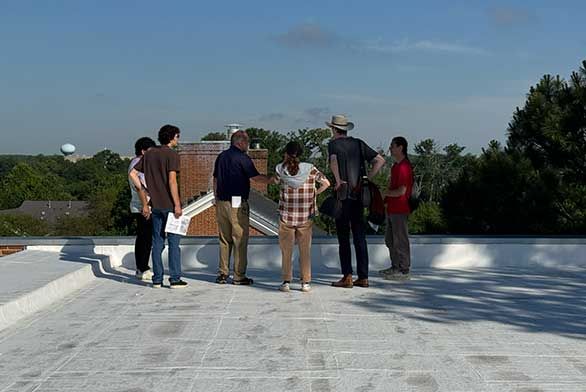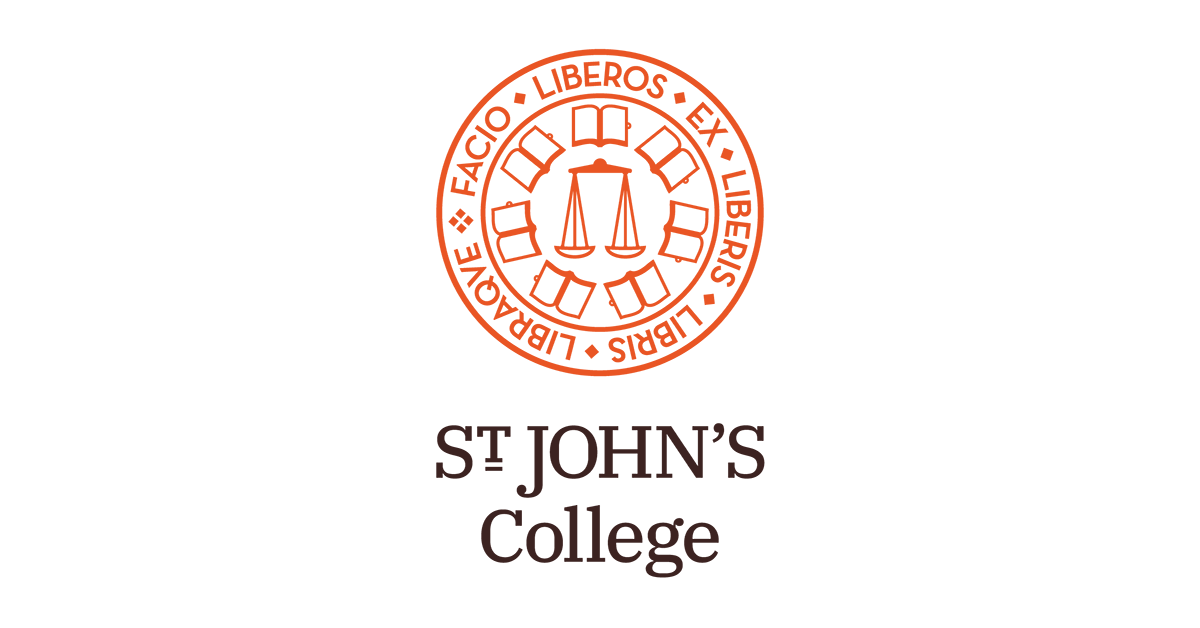Newly Installed Solar Array Provides St. John’s College Annapolis with Renewable Energy—and Paid Summer Jobs for Johnnies
September 22, 2025 | By Gabriela Forte (A27)
St. John’s College has long invested in sustainability projects on campus, including geothermal heating, a living shoreline, rain gardens, and energy efficiency improvements continually being made to its historic buildings. This path to a greener future continues with a new project to install solar panels on the roof of Mellon Hall and the college’s heating plant building—upgrades that began this summer with the assistance of paid Johnnie interns and made possible thanks to the Maryland Energy Administration (MEA).

MEA recently introduced the Higher Education Clean Energy Grant Pilot Program: a new program focused on developing sustainability initiatives at institutions of higher education in the State of Maryland. It offers grants for schools to transition to cleaner energy practices and to provide internships so that students are equipped with the skills they need to thrive in the sustainability and renewable energy sectors.
St. John’s Director of Foundation Relationships Ruth Decalo secured one for St. John’s College this past year, allowing Annapolis colleagues Ally Gontang-Highfield, CFO and Vice President of Finance and Operations, and John M. Davis, Director of Campus Facilities and Projects, to begin the long-anticipated solar array project alongside a team of undergraduates. Overseen by architecture firm Kezlo Group and installed by Solar Energy Services, a Johnnie-led local energy company helmed by Ethan Goddard (A14), the array is slated for completion in 2026.
For higher education institutions, which require a great number of resources to function (allocated toward basic residence hall utilities, student activity spaces, and classroom maintenance), sustainability projects minimize energy expenses and cut waste, making communal spaces greener and more cost-effective. This spells success for all involved: students get the opportunity to live on campuses worth their dime, and schools save money. Beyond that, all involved get the chance to involve themselves in the effort toward a greener world and to make their mark.
Campus sustainability has always been a priority and a challenge for Davis, who, before overseeing the solar array project, began implementing small changes to the campus that will ultimately make a big difference down the line. St. John’s historical status means that buildings are harder to renovate and more expensive to power, a problem requiring more creative solutions than the average university.
“We have to jump through a lot of hoops to make improvements to buildings. We have very inefficient windows, for example,” Davis says. Since the Historic Preservation Commission for the City of Annapolis prohibits external renovations to historic structures without approval, extensive work must be completed from the inside. “All of our buildings have air conditioning except the gym,” Davis explains, “but insulation is poor in these buildings, so it is hard to keep the buildings cool.”
Davis has begun installing LED lightbulbs in all campus buildings, a time-consuming process when combined with all other maintenance required throughout the year. But it is well worth it: according to the Department of Energy, LED lightbulbs save at least 75 percent more energy than their incandescent counterparts, and they last up to 25 times longer.
St. John’s Campus Facilities office has also worked to make Mellon Hall more energy-efficient by preventing HVAC air from leaking outside open windows and drafty rooms. To make Mellon “airtight,” so to speak, not only do windows and doors need to be repaired, but the HVAC system must operate at comfortable temperatures year-round to prevent excessive window-opening that would leak the air out anyway. While these two projects may seem small in comparison to the ongoing solar array project, their success will go a long way in opening resources for other parts of campus life.
Gontang-Highfield spent most of her career at environmental nonprofits before transitioning to higher education. Having worked for places like the Chesapeake Bay Foundation and the Eastern Shore Land Conservancy, she searches for sustainability opportunities wherever she can. By the time Gontang-Highfield first learned about the Higher Education Clean Energy Grant Pilot Program, she had already worked with the St. John’s Santa Fe facilities team to make strides in solar power: Inspired by the St. John’s College Santa Fe Class of 2019’s senior class gift, which was an energy audit of the campus, the polity there used philanthropic funds in 2023 to complete a vast ground-mount solar panel project that offsets 100 percent of the campus’s electric power usage.
Along the way, Gontang-Highfield began brainstorming how feasible a similar initiative might be for Annapolis. “We don’t have the sunshine that they necessarily have in Santa Fe,” Gontang-Highfield says, nor the campus’s available ground, acreage, and abundance of Pueblo Revival rooftops. Plus, she adds, “We have probably four or five times the electrical bill that Santa Fe has, just by having such historical buildings.” Funding was a concern as well. But amid these obstacles, St. John’s Annapolis boasted one advantage: the wide, flat roofs of Mellon Hall and the heating plant, both of which could feasibly host an abundance of solar panels.
This hypothetical finally became a reality once St. John’s received the MEA grant in 2025, enabling Gontang-Highfield and Davis to kickstart the construction process in May while paying a team of Johnnies to work alongside them. Under the guidance of their faculty advisor, tutor Sarah Benson, these student employees lobbied for project approval from the Annapolis Historic Preservation Commission and researched other potential campus sustainability projects, like planting native grasses to combat flooding. Some even received training through the Occupational Safety and Health Administration (OSHA) to assist with the solar array’s build.
Solar project intern Abhigya Adhikari (A26) has a clear vision of what St John’s could accomplish in terms of a cleaner energy future. For him, some goalposts are well within sight: “We’re already lowering consumption to the best of our abilities,” Adhikari says. “From the institutional side,” he adds, “renovations and retrofitting and a little extra effort from people will get us to our goal very easily.”
But lowered utility costs, he adds, could also provide St. John’s with opportunities to reinvest savings into the student body by building stronger student support systems, creating new work-study positions, and funding energy-saving communal appliances for Johnnies, such as shared microwaves and kettles in the common rooms of residence halls. Tangible benefits like these would allow Adhikari’s efforts this past summer to live on long after his graduation next spring; for him, he concludes, that would be “the greatest sort of way to give this solar campaign its sustainable touch.”

